Benga Secondary School
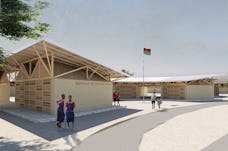
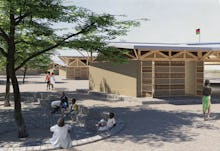
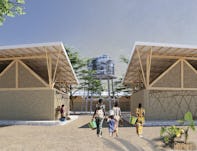

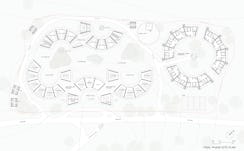

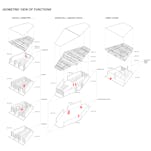
EMBRACING COMMUNITY:
“The whole is greater than the sum of its parts”
Representing the societal support children need in their formative years, the design of Embracing Community brings individual components together to create a stronger whole. The radial layout of the master plan components create larger and smaller scale indoor and outdoor spaces and with a minimum of three combined modules provides structural stability.
The modular design of the complex allows for growth, with a focus on materials and building techniques that are readily available and can be built with a local workforce:
Corrugated Metal:
Corrugated metal roofing provides effective weather shield from both rain and sun.
It also allows for controlled rainwater collection, making it worth the expense of purchasing this material.
Wood Trusses:
The roof wood support structure follows a modular kit system, identical in all buildings. The modules are sized to withstand wind and rain forces, support the load of the PV system, and create the roof pitch. The lumber can be from local or outside sources as necessary.
Thatch:
Locally sourced reed mats, woven by local workers, serve as a heat and sound buffer under the roof. Set into the web of the truss structure, these create a pitched ceiling to absorb sound and provide airflow for heat to escape, as well as introducing an elegant decorative element in the construction. Thatch is also used to cover the framed wall components at each end of the building modules.
Rammed Earth:
Using earth from the site mixed with a small amount of cement and plant fiber for reinforcing, the rammed earth walls can be built by local craftspeople. The ample roof overhang is designed to protect the rammed earth walls from rain, but the exterior facing walls can also be coated with a decorative plaster for added protection from potential weather damage. The rammed earth walls also have a thermal buffer effect to help diminish temperature peaks. The formwork for the walls can be reused for all construction phases.
Cobbles:
Fieldstones or simple burned clay bricks provide solid footing, particularly during rain season. The cobbled surface channels water away from the buildings and walkways to rain ditches. Controlled runoff helps irrigate vegetation while providing dry and stable walking surfaces.
Concrete blocks:
Solid concrete block foundations provide secure and water resistant bases for rammed earth walls, if block-making equipment is available. Fieldstone and poured concrete foundations are a viable alternative if necessary.